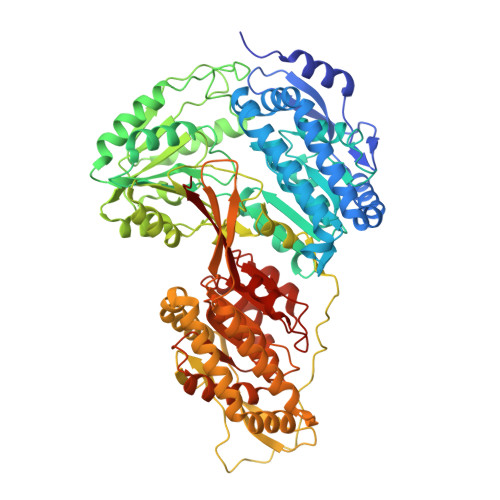Crystal Structure of Aldehyde Dehydrogenase 16 Reveals Trans-Hierarchical Structural Similarity and a New Dimer.
Liu, L.K., Tanner, J.J.(2019) J Mol Biology 431: 524-541
- PubMed: 30529746
- DOI: https://doi.org/10.1016/j.jmb.2018.11.030
- Primary Citation of Related Structures:
6MVR, 6MVS, 6MVT, 6MVU - PubMed Abstract:
The aldehyde dehydrogenase (ALDH) superfamily is a vast group of enzymes that catalyze the NAD + -dependent oxidation of aldehydes to carboxylic acids. ALDH16 is perhaps the most enigmatic member of the superfamily, owing to its extra C-terminal domain of unknown function and the absence of the essential catalytic cysteine residue in certain non-bacterial ALDH16 sequences. Herein we report the first production of recombinant ALDH16, the first biochemical characterization of ALDH16, and the first crystal structure of ALDH16. Recombinant expression systems were generated for the bacterial ALDH16 from Loktanella sp. and human ALDH16A1. Four high-resolution crystal structures of Loktanella ALDH16 were determined. Loktanella ALDH16 is found to be a bona fide enzyme, exhibiting NAD + -binding, ALDH activity, and esterase activity. In contrast, human ALDH16A1 apparently lacks measurable aldehyde oxidation activity, suggesting that it is a pseudoenzyme, consistent with the absence of the catalytic Cys in its sequence. The fold of ALDH16 comprises three domains: NAD + -binding, catalytic, and C-terminal. The latter is unique to ALDH16 and features a Rossmann fold connected to a protruding β-flap. The tertiary structural interactions of the C-terminal domain mimic the quaternary structural interactions of the classic ALDH superfamily dimer, a phenomenon we call "trans-hierarchical structural similarity." ALDH16 forms a unique dimer in solution, which mimics the classic ALDH superfamily dimer-of-dimer tetramer. Small-angle X-ray scattering shows that human ALDH16A1 has the same dimeric structure and fold as Loktanella ALDH16. We suggest that the Loktanella ALDH16 structure may be considered to be the archetype of the ALDH16 family.
- Department of Biochemistry, University of Missouri, Columbia, MO 65211, USA.
Organizational Affiliation:



















